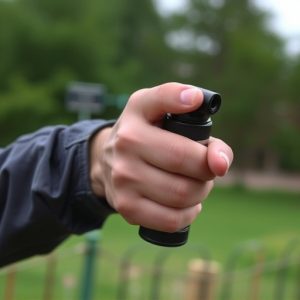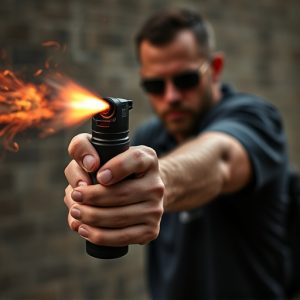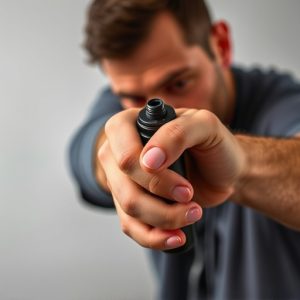Pepper Spray Law Enforcement: Safe Use & Effectiveness Explored
Pepper spray, a globally used riot control agent, temporarily incapacitates targets through chemical…….
Pepper spray, a globally used riot control agent, temporarily incapacitates targets through chemical irritation, aiding law enforcement in managing chaotic situations. Its strategic deployment is crucial for officer safety and responsible use, with proper training emphasizing assessment of dynamic threats and exhaustion of alternative methods. The "When to Use Pepper Spray Safely" framework ensures minimal harm to bystanders while maintaining public safety and respecting civil liberties. Case studies highlight its effectiveness but also the importance of avoiding abusive or inappropriate use, emphasizing the need for nuanced deployment strategies and robust officer training.
Riot control agents, such as pepper spray, have become integral tools in law enforcement, offering a crucial tactical advantage during high-risk situations. This article delves into the intricacies of these powerful tools, focusing on understanding and using pepper spray safely and responsibly. From legal frameworks governing its application to practical case studies, we explore when it’s justified and safe handling techniques. Learn how optimal effectiveness can be achieved while ensuring public safety in various law enforcement scenarios.
- Understanding Riot Control Agents: An Overview of Pepper Spray
- Legal Framework and Regulations Governing Pepper Spray Use by Law Enforcement
- When is Pepper Spray Justified in Law Enforcement Situations?
- Safe Handling and Deployment Techniques for Optimal Effectiveness
- Case Studies: Effective (and Ineffective) Use of Pepper Spray on the Ground
Understanding Riot Control Agents: An Overview of Pepper Spray
Pepper spray, a common riot control agent, is a powerful tool used by law enforcement agencies worldwide. It’s a chemical substance designed to cause temporary blindness and respiratory distress in its target, rendering them non-threatening for a period of time. This allows officers to regain control of chaotic situations, such as protests that have turned violent or crowd control during high-risk events.
When used safely and according to protocol, pepper spray can be a game-changer for law enforcement. It’s particularly effective in close-quarters encounters where other less-lethal force options might not be feasible. Officers are trained to deploy it strategically, ensuring minimal harm to bystanders and focusing on disrupting the behavior that poses an immediate threat. Understanding its mechanism of action and proper application techniques is crucial for both officers’ safety and the responsible use of this powerful tool.
Legal Framework and Regulations Governing Pepper Spray Use by Law Enforcement
The legal framework surrounding pepper spray usage by law enforcement is a critical aspect of maintaining public safety and ensuring accountability. In many jurisdictions, the use of pepper spray is governed by specific regulations that outline when, how, and under what circumstances it can be deployed. These rules are designed to balance the need for effective riot control with the prevention of excessive force and respect for civil liberties. Law enforcement agencies must adhere to strict protocols, ensuring officers are trained in safe and proportionate use, which includes understanding when pepper spray is an appropriate tool among other less-lethal options.
When to Use Pepper Spray Safely involves assessing a dynamic situation where the potential threat to public safety or the officer’s own wellbeing outweighs alternative methods. It is often used as a last resort when other de-escalation techniques have failed, and physical force may be required to control a situation involving rioting, mass gatherings, or aggressive individuals who pose an imminent danger. The legal implications of pepper spray use are taken seriously, with oversight bodies monitoring its deployment to ensure compliance with regulations and protect both the community and law enforcement personnel from potential abuses of power.
When is Pepper Spray Justified in Law Enforcement Situations?
In law enforcement situations, pepper spray, also known as oleoresin capsicum (OC) spray, is a riot control agent used to incapacitate and subdue individuals who pose an immediate threat or are resistant to other less-lethal force methods. Its use is carefully regulated and justified based on several factors. Officers are trained to consider the following when determining if pepper spray is appropriate: the individual’s behavior, their potential for causing harm, and whether other de-escalation tactics have been exhausted without success.
The use of pepper spray should be a last resort when all other attempts to resolve the situation peacefully have failed. It is crucial to ensure that the force used is proportional to the threat presented, balancing public safety with the rights of individuals. Additionally, officers must be familiar with their department’s policies and procedures for deploying pepper spray, including safe application techniques and decontamination protocols, to guarantee its responsible and effective use.
Safe Handling and Deployment Techniques for Optimal Effectiveness
When to Use Pepper Spray Safely, a crucial aspect of riot control agent deployment, involves understanding optimal effectiveness and safe handling practices. Law enforcement agencies must train their officers extensively on the appropriate use of pepper spray to ensure it remains a powerful yet controlled tool during chaotic situations. The safe handling technique begins with proper storage, where canisters should be kept secure, out of reach, and clearly labeled to prevent unauthorized access.
Deployment techniques vary based on the nature of the disturbance. For crowd control, officers strategically position themselves and use calculated bursts of pepper spray to target specific individuals or areas without endangering bystanders. In close-quarters confrontations, direct application with a focused stream can effectively incapacitate suspects while minimizing collateral damage. Always adhering to safety protocols, including wearing protective gear, ensures the well-being of both officers and civilians during operations involving riot control agents.
Case Studies: Effective (and Ineffective) Use of Pepper Spray on the Ground
Pepper spray, a common riot control agent, has been both celebrated and criticized for its use in law enforcement. Case studies reveal its effectiveness in de-escalating tense situations and dispersing crowds, particularly when used strategically. For instance, during protests, pepper spray can be deployed from a safe distance to break up groups without causing permanent harm, allowing officers to maintain control while minimizing civilian injuries.
However, the ineffective or abusive use of pepper spray can lead to severe consequences. When employed too close to individuals or targeted at vulnerable populations like children or the elderly, it may result in panic, breathing difficulties, and even long-term health issues. These negative outcomes underscore the importance of understanding when and how to use pepper spray safely. Training officers on its responsible deployment is crucial to ensure public safety and maintain the integrity of law enforcement operations.
Riot control agents, particularly pepper spray, are powerful tools for law enforcement, but their use must be carefully regulated and justifiable. Understanding the legal framework, safe handling practices, and effective deployment techniques is crucial for maximizing their effectiveness while minimizing harm. By learning from both successful and ineffective case studies, law enforcement agencies can navigate challenging situations, ensuring public safety and adhering to strict regulations regarding when to use pepper spray safely.


